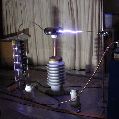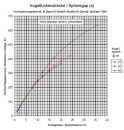
Nicely controllable power
supply: DC-HV cascade
KNH34 -30kV/5mA
from Eltex GmbH
128'013 bytes

2nF/40kV Doorknob cap
manuf. by Vishay/Sprague
Cera Mite corporation
20'182 bytes

Metallux HV Resistors
31'335 bytes

Schematic diagram
of the 20 stage Marx
45'134 bytes

A 5-stage 150kV
Pilot Mini-Marx
was buildt first
77'197 bytes

Pilot Marx,
firing 18cm
71'591 bytes

20-stage Marx.
Polystyrene-glass plates:
140cm x 13.5cm x 0.5cm
77'882 bytes

20-stage Marx,
67cm discharge
between points
105'891 bytes

Zoom of discharge
60'870 bytes

stainless steel
d=30cm "gazing balls"
(slightly ferromagnetic)
72'358 bytes

22cm discharge pulse
in 30cm-sphere-gap
(right sphere grounded)
86'034 bytes

22cm pulse + small
additional pulse to air
from grounded(+)sphere
77'638 bytes

22cm pulse, with multiple
starters from (-) sphere.
Note the ionized air cloud
84'117 bytes

Misfiring 22cm pulse, with
multiple starters from (-).
Note the ionized air cloud
65'857 bytes

Sphere-gap
spark-table diagram
68'728 bytes
following F.Fruengel
Impulstechnik, 1960
( Excel spreadsheet )